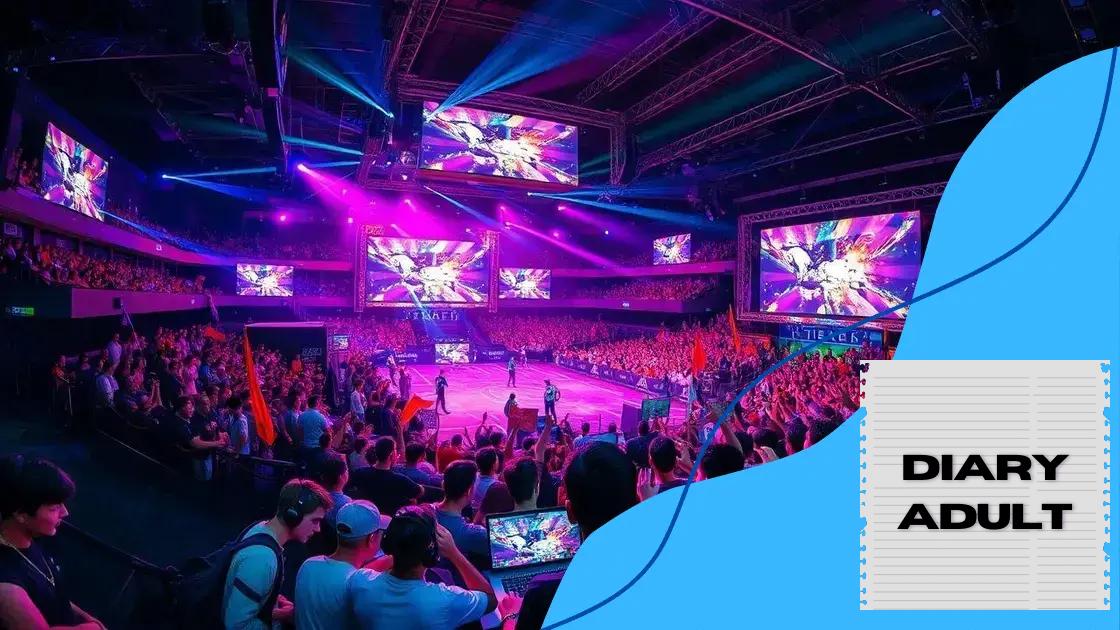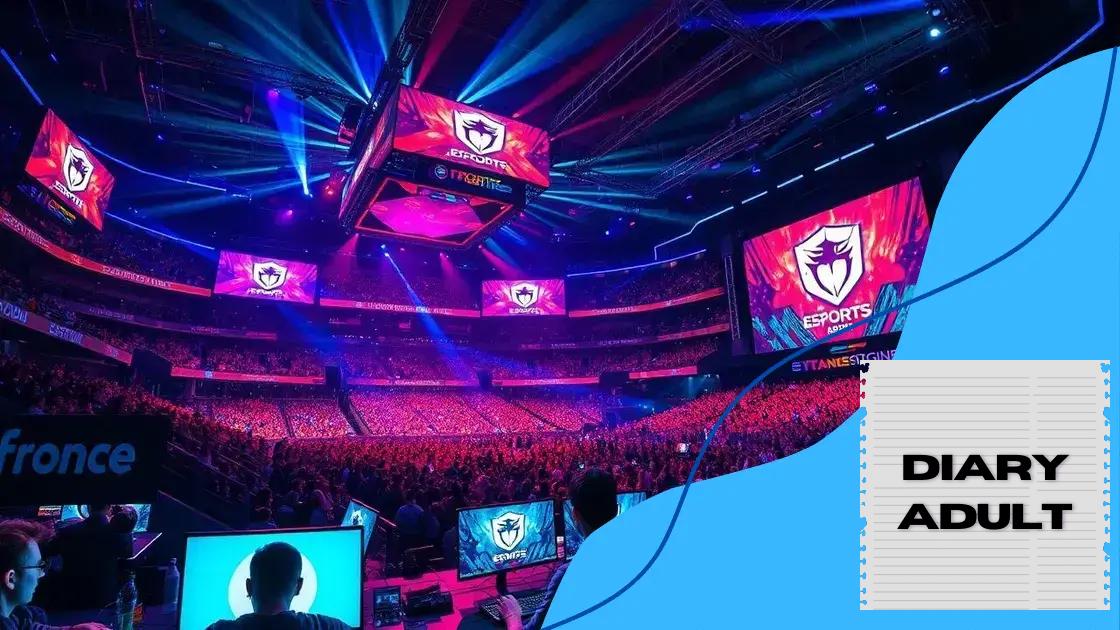How e-sports are influencing mainstream media content

How e-sports are influencing mainstream media content includes increased live broadcasting, innovative storytelling, and integration of virtual and augmented reality, significantly enhancing viewer engagement and brand collaboration.
How e-sports are influencing mainstream media content is a transformation we’re witnessing today. You might wonder, how does the energy of gaming shift storytelling in broadcasts? Let’s dive into that.
Understanding the rise of e-sports
The rise of e-sports is changing the landscape of entertainment and media. Gamers are no longer just playing for fun; they are competing on the world stage. This shift has drawn attention to how these competitive games can attract large audiences.
What Are E-sports?
E-sports refers to competitive video gaming where individuals or teams compete against each other in various game titles. Unlike traditional sports, e-sports encompass diverse genres, from first-person shooters to real-time strategy games.
The Growth of E-sports
Over the past decade, there has been an incredible surge in e-sports popularity. Events can draw millions of viewers, both online and in-person. Many factors contribute to this growth, including:
- The increasing accessibility of gaming technology.
- The rise of streaming platforms like Twitch.
- Major investments from corporations and sponsorship deals.
As more people engage with e-sports, it’s clear that the audience is expanding. Younger generations are more inclined to watch streaming content rather than traditional television.
Demographics of E-sports Viewers
Understanding who watches e-sports is key to grasping its impact. The viewer demographic is diverse, but certain trends are prevalent. For instance, a majority are under 35 years old and engage regularly with online content.
Fans often have a deep connection to their favorite teams and players, similar to traditional sports. This connection fosters community through fan interactions online, whether via social media or live chats during tournaments. As e-sports continues to grow, its influence reaches beyond the gaming realm, shaping how media content is created and consumed.
The impact of e-sports on traditional media
The impact of e-sports on traditional media is becoming increasingly significant. As more viewers tune into online streams, traditional broadcasting methods are being compelled to adapt. Major networks are now investing in e-sports events, showcasing tournaments that attract millions of fans.
Changing Viewership Trends
With the rise of e-sports, there is a noticeable shift in how audiences consume content. Younger viewers are opting for live streams over cable television, which impacts advertising and programming strategies.
- Viewers prefer interactive content over passive watching.
- Competitive gaming attracts a diverse audience.
- Many traditional media outlets are now including e-sports in their schedules.
This new trend challenges established norms, prompting media companies to innovate. For example, some networks have created dedicated channels and segments for e-sports coverage, drawing inspiration from sports broadcasting.
Collaborations and Sponsorships
Partnerships between e-sports teams and brands are flourishing. Companies recognize the influence of gaming culture and seek to reach enthusiastic fans through sponsorships and advertisements. This synergy not only enhances brand visibility but also enriches the gaming experience for viewers.
As brands invest more in e-sports, traditional media must find ways to integrate these partnerships into their content. This integration can take many forms, such as co-branded events and integrated advertising strategies that appeal to gamers.
How brands are leveraging e-sports

Brands are increasingly finding innovative ways to leverage e-sports to connect with younger audiences. By tapping into the vibrant culture of gaming, these companies can engage fans in unique and interactive ways. From sponsorships to partnerships, the possibilities are vast and exciting.
Sponsorship Opportunities
Many brands sponsor e-sports teams or tournaments, gaining visibility among dedicated fans. This sponsorship can take several forms:
- Branding on team uniforms.
- Advertising during live streams.
- Exclusive merchandise collaborations.
Such partnerships allow brands to gain exposure during high-profile matches, where millions watch their favorite teams compete. This visibility fosters a sense of loyalty among fans, not only to the teams but also to the brands that support them.
Influencer Collaborations
Another effective strategy is partnering with popular e-sports influencers. These content creators have large followings and can impact purchasing decisions. By collaborating with these influencers, brands can reach audiences in an authentic way.
Brands often engage influencers for product placements in gaming streams or promotional content. This creates a more genuine connection between the product and the audience, enhancing brand trust.
Interactive Marketing Campaigns
Brands are also creating interactive marketing campaigns tailored to e-sports fans. This includes engaging polls, contests, or giveaways that coincide with major gaming events. These strategies enhance audience participation and ideally lead to a deeper emotional connection.
Through these campaigns, companies can gather valuable insights about their target demographic, refining their marketing strategies and product offerings.
Audience engagement strategies in e-sports
Audience engagement strategies in e-sports are key to building a loyal fan base. Engaging fans helps create a community that supports players and teams. As e-sports continues to grow, brands and organizations are finding creative ways to connect with supporters.
Interactive Live Streaming
One of the most popular ways to engage audiences is through interactive live streaming. Platforms like Twitch allow viewers to interact with streamers in real-time. This interaction includes:
- Chat features that let fans communicate.
- Polls for voting on game strategies.
- Donations that support their favorite players.
This level of interaction enhances the viewing experience and fosters a sense of belonging among fans. By making viewers feel involved, organizers can keep their audience invested.
Community Building Events
Organizing community events is another effective strategy. These can include fan meet-ups, workshops, and tournaments. When fans come together, they form connections with one another and the team they support. This community spirit strengthens loyalty.
Events often feature:
- Q&A sessions with players.
- Hands-on gaming experiences.
- Exclusive merchandise giveaways.
These activities create memorable experiences, turning casual viewers into dedicated fans. Additionally, teams can use social media to keep fans informed about upcoming events, making participation easy.
Gamified Experiences
Implementing gamified experiences is also growing in popularity. This can involve creating challenges or competitions for fans to participate in. E-sports teams often use apps or websites where fans can earn rewards for following and supporting their favorite teams.
By engaging fans with challenges, teams create excitement and encourage participation in various activities, such as:
- Predicting match outcomes.
- Joining fantasy leagues.
- Participating in team-themed games and challenges.
These strategies help maintain interest and encourage ongoing engagement with the brand as it grows in popularity.
Future trends in e-sports and media collaboration
Future trends in e-sports and media collaboration are set to evolve rapidly. As the gaming industry expands, media organizations are discovering new ways to integrate and promote gaming content. This collaboration is reshaping entertainment and media consumption.
Increased Live Broadcasting
One major trend is the increase in live broadcasting of e-sports events. Traditional media outlets are stepping up their coverage, offering real-time access to tournaments. This shift allows fans to watch competitions as they happen, bringing excitement and immediacy.
- Collaborations between gaming platforms and broadcasters.
- Real-time statistics and analytics for viewers.
- Behind-the-scenes content during live events.
These enhancements improve the viewing experience, keeping fans engaged throughout the events. Media companies are increasingly investing in technology to deliver high-quality streams and dynamic content related to e-sports.
Innovative Storytelling
Another growing area is the development of innovative storytelling around e-sports personalities and teams. Documentaries and series focused on players’ journeys, team dynamics, and fan experiences are becoming more popular. This content delves into the lives of gamers, creating deeper connections with the audience.
By telling these personal stories, brands can humanize players and add emotional depth to the e-sports experience. This not only attracts existing fans but also draws in new viewers unfamiliar with the gaming world.
Integration of Virtual Reality and Augmented Reality
The integration of Virtual Reality (VR) and Augmented Reality (AR) is on the rise in e-sports. These technologies enhance player experiences for both gamers and viewers. Fans can participate in immersive experiences that bring them closer to the action.
Using VR, fans can feel as if they are in the arena, experiencing the energy firsthand. In contrast, AR can provide real-time stats and information layered over the live stream, enriching the viewing experience. This creates opportunities for brands to explore new advertising methods and interactive content.
Global Expansion of E-sports
As e-sports gains traction worldwide, media collaborations will expand globally. New markets in Asia, Africa, and South America show growing interest. This expansion will offer brands new opportunities to engage different audiences.
By tailoring content to various cultures and preferences, media will make e-sports more accessible and appealing. As global interest grows, expect more international tournaments and regional leagues, boosting the overall visibility of e-sports.
In conclusion, the future of e-sports and media collaboration looks bright. Both industries are blending traditional broadcasting with innovative technology to create dynamic experiences. As e-sports continues to rise, we can expect exciting developments in how fans engage and interact with their favorite games and players. By embracing these trends, companies can reach wider audiences and foster deeper connections. The possibilities for growth and collaboration are endless, making it an exciting time to be part of the e-sports community.
FAQ – Frequently Asked Questions about e-sports and media collaboration
What is driving the growth of e-sports?
The growth of e-sports is driven by increasing viewership, media coverage, and technological advancements that make gaming more accessible.
How do brands benefit from sponsoring e-sports events?
Brands benefit by gaining visibility in front of a dedicated audience and establishing a connection with younger consumers who are passionate about gaming.
What role does technology play in the future of e-sports?
Technology plays a vital role by enabling live broadcasting, enhancing user experiences through VR and AR, and providing interactive platforms for fans.
How can fans engage more with e-sports teams?
Fans can engage by participating in live streams, attending events, joining fan clubs, and interacting on social media platforms.





